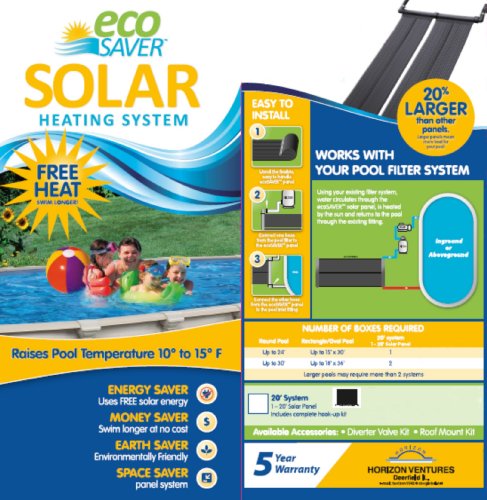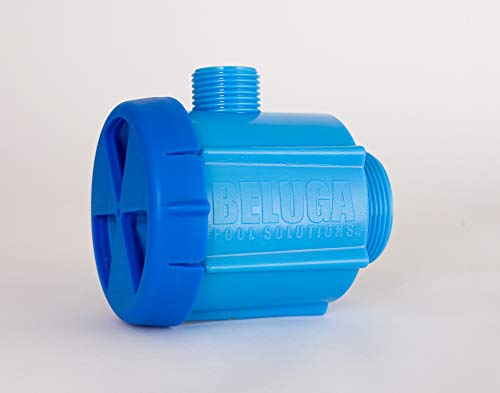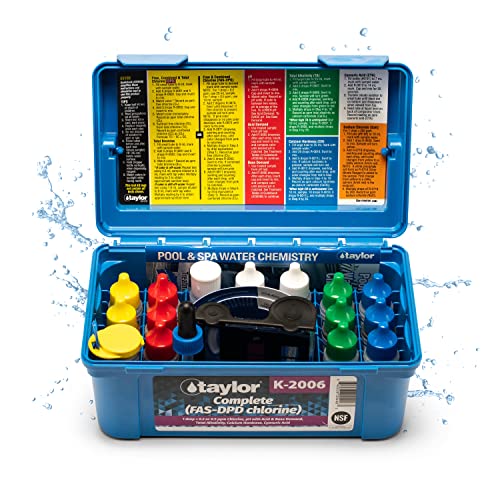In this step-by-step guide, we will outline the key steps to extend the lifespan of your solar-powered swimming pool heater. First, we will discuss how to clean and maintain the solar panels to maximize their efficiency. Next, we will provide tips on how to properly balance the pool water chemistry to prevent damage to the heater. We will also cover the importance of regular inspections and check-ups to identify any potential issues early on. Finally, we will talk about how to protect your solar heater from extreme weather conditions and natural hazards. By following these steps, you can significantly increase the lifespan of your solar-powered swimming pool heater and enjoy a heated pool for years to come.
Top-rated Solar Pool Heaters
Clean the solar panels
To clean the solar panels, start by regularly removing any dirt, debris, or leaves that may accumulate on the surface. Use a soft brush and gentle detergent to scrub the panels, making sure to be gentle so as not to scratch or damage them. Rinse the panels thoroughly with water and allow them to dry completely before reconnecting. Regularly cleaning the panels will ensure their optimal performance and efficiency.
Inspect for leaks
To inspect for leaks, first, check the connections and pipes for any signs of leaks. Look closely for water drips or wet spots around the system. If you find any leaks, take immediate action to prevent further damage and ensure efficient operation. Repair or replace the damaged parts as necessary.
To summarize:
- Check connections and pipes for leaks.
- Look for water drips or wet spots.
- If leaks are detected, repair or replace the damaged parts.
Check the water pH levels
Test the water pH levels regularly using a pool water testing kit. This simple step is crucial for maintaining the correct water chemistry and ensuring the longevity of your solar-powered pool heater. Start by collecting a water sample from your pool using a clean container. Follow the instructions on your testing kit to measure the pH level of the water sample. If the pH level is outside the ideal range of 7.2 to 7.8, you will need to adjust it to prevent corrosion or scale buildup in the heater. To raise the pH level, add a pH increaser product according to the manufacturer’s instructions. To lower the pH level, use a pH reducer. Be sure to follow the recommended dosages and wait the recommended time before retesting the water. By regularly checking and adjusting the water pH levels, you can ensure optimal performance and a longer lifespan for your solar-powered pool heater.
Inspect and clean the pump
Inspecting and cleaning the pump is crucial for maintaining the efficiency and performance of your solar panel system. Regular inspection helps identify any potential issues before they turn into major problems. Start by visually examining the pump for any signs of damage, such as cracks or leaks. Check all the connections and wires for loose or corroded parts.
Next, clean the pump basket to ensure optimal functioning. Turn off the pump and disconnect it from the power source. Remove the lid of the pump basket and carefully empty its contents into a bucket. Use a hose or a gentle stream of water to rinse off any debris stuck to the basket. Pay special attention to the edges and corners where dirt tends to accumulate.
In case of any clogs, use a small brush or your fingers to remove the debris from the impeller, which is located inside the pump. Make sure you remove any twigs, leaves, or other objects that may obstruct the impeller’s movement.
Lastly, if the pump motor requires lubrication, refer to the manufacturer’s instructions for the recommended lubricant and application method. Generally, a few drops of lubricant on the motor shaft or bearings should suffice. Be cautious not to over-lubricate.
Regularly inspecting and cleaning your pump will help prolong its lifespan and ensure proper water circulation throughout your solar panels. By following these simple steps, you can maintain the efficiency of your system and prevent any potential issues.
Protect from extreme weather conditions
Protect Your Solar-Powered Pool Heater during periods of extreme weather conditions.
Cover the panels or disconnect them from the pool system to prevent any damage. Ensure that the panels are completely covered with a durable and waterproof material, such as a tarp or heavy-duty plastic sheet. This will protect them from heavy rain, hail, or snow, which can cause potential damage.
If covering the panels is not possible, consider disconnecting them from the pool system altogether. By doing so, you can eliminate the risk of damage to the panels or any connected equipment during extreme weather. Make sure to follow the manufacturer’s instructions on how to safely disconnect the panels to avoid any issues.
In addition to protecting the solar panels, installing a pool cover is also recommended. A pool cover will provide an extra layer of protection to your pool, shielding it from the harsh elements brought by extreme weather conditions. This will help to minimize potential damage and maintain the integrity of your pool system.
Remember, taking proactive measures to protect your solar-powered pool heater during extreme weather is essential to ensure its longevity and optimal performance.
Schedule professional maintenance
Schedule professional maintenance at least once a year for your solar-powered pool heater. Contact a qualified technician to inspect and service the system. Ensure its optimal performance and identify any potential issues during the maintenance appointment.
Practical Tips for Longevity
In conclusion, taking the necessary steps to maintain your solar-powered swimming pool heater will greatly enhance its lifespan. By regularly cleaning the panels, inspecting for leaks, monitoring water pH levels, cleaning the pump, protecting against extreme weather, and scheduling professional maintenance, you can ensure that your heater operates efficiently and cost-effectively for years to come. So, go ahead and follow these guidelines to get the most out of your solar-powered swimming pool heater.
Necessary Equipment
Efficient Maintenance Methods
Step-by-step guide to using solar-powered swimming pool heaters
- Position the solar panels: Start by determining the best location for installing the solar panels. Look for an area that receives maximum sunlight throughout the day, preferably with minimal shading. It is recommended to position the solar panels facing south and at an angle that is equal to the latitude of your location
- Connect the solar panels: Once the panels are in place, connect them to the existing pool filtration system. This usually involves plumbing connections, such as connecting the solar panels to the pool pump and making sure the flow direction is correct. If you are unsure, it is best to consult a professional plumber or pool technician
- Set up the controller: Solar-powered swimming pool heaters often come with a controller that allows you to easily manage and monitor your system. Follow the manufacturer’s instructions to set up the controller, which may include setting the desired pool temperature, adjusting the flow rate, or programming an automatic schedule
- Monitor and maintain the system: Regularly check the solar panels for dirt, debris, or any obstructions that may reduce their efficiency. Clean them if necessary, ensuring they are free from dust or leaves. Additionally, monitor the water temperature and system performance to ensure everything is functioning optimally. In case of any issues, refer to the user manual or contact the manufacturer for support
- Full system shutdown: If you plan to stop using the solar-powered swimming pool heater for an extended period, such as during winter months, it is important to properly shut down the system. This may involve draining any remaining water from the panels and disconnecting them from the pool filtration system. Again, refer to the manufacturer’s instructions or consult a professional if needed
- Remember, while using solar-powered swimming pool heaters can be a cost-effective and environmentally friendly way to heat your pool, it is important to follow the specific instructions provided by the manufacturer to ensure safe and efficient operation
Frequently Asked Questions about Solar-powered Swimming Pool Heaters
Are there any limitations or downsides to using a solar-powered swimming pool heater?
When it comes to using a solar-powered swimming pool heater, there are a few limitations and downsides to consider. Here are a few of them:
- Dependence on Sunlight: Solar heaters rely on the availability of sunlight to function efficiently. This means that they may not be as effective on cloudy days or during the winter season when sunlight is limited. In these situations, the heater’s performance may be reduced, resulting in a slower or insufficient heating of the pool water.
- Initial Investment: The upfront cost of installing a solar-powered pool heater can be higher compared to other options such as gas or electric heaters. The expense includes not only the solar panels but also additional equipment and installation costs. However, it’s important to note that this initial investment can be offset by long-term energy savings.
- Size and Space Requirements: Solar panels require sufficient space to be installed, typically on the roof or in the backyard where they can receive adequate sunlight. The size of the solar panels needed will depend on factors such as the size of your pool and the desired water temperature. So, it’s essential to ensure that you have enough available space to accommodate the required number of panels.
- Seasonal Variations: Solar heaters may have varying efficiency levels throughout the year due to changes in sunlight intensity and duration. During summer, when there is more sunlight, the heater may be able to reach and maintain higher temperatures. However, during colder months or in regions with fewer daylight hours, the heating capacity of the solar panels may be reduced.
- Additional Components: In addition to the solar panels, you may need to invest in other components such as pumps, valves, and controls to ensure proper circulation and efficiency of the system. These additional components may incur extra costs and require regular maintenance.























